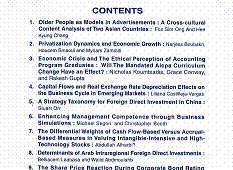Journal of Business and Policy Research
Vol. 12. No. 2., December 2017, Pages: 1 – 13
Examining Systematic Risk with Principal Component Analysis: An Empirical Analysis in Hong Kong Stock Market
Raymond Kwong and Ricky K.L. Mak
This paper proposes a two-step approach to examine the macroeconomic determinants of systematic risk. The first step takes as systematic risk the first principal component in a portfolio that explains the largest variance from a Principal Component Analysis (PCA). The second step examines the macroeconomic determinants that constitute systematic risk. Applying the approach to monthly data of 189 stocks in 11 sector portfolios in Hong Kong, the findings show that the unemployment rate and trade balance are the significant factors constituting systematic risk. Further, systematic risk is autoregressive and has a non-zero mean. The error correction force of the long-run equilibrium between the co-integrated series unemployment rate and trade balance significantly contributes to the systematic risk.
DOI :
https://doi.org/10.21102/jbpr.2017.12.122.01

